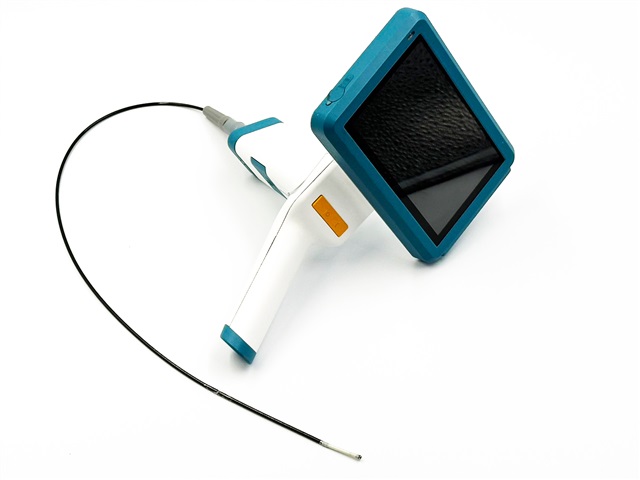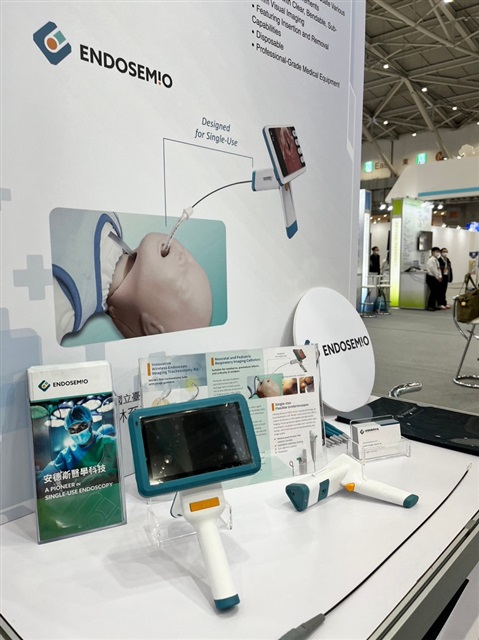Endoscopes play an instrumental role in minimally invasive surgeries.
They allow doctors to perform inspection and treatment procedures inside the body using smaller surgical cuts or even without cuts while increasing surgical precision. EndoSemio's single-use endoscope developed on the foundation of miniature imaging devices and high biocompatibility tubing materials boosts surgical safety, drives technological innovations, and satisfies special healthcare needs. With EndoSemio's single-use endoscope, hospitals will be able to improve patient experience.
Leveraging technological and medical strengths, EndoSemio overcomes the shortcomings of traditional endoscopes
Ting-Xuan Chen and Chih-Peng Lin co-founded EndoSemio. Chen worked for the Industrial Technology Research Institute (ITRI) in charge of helping medical research organizations turn clinical needs into products.
Lin is an attending physician and director of the Division of Pain Management, Department of Anesthesiology, National Taiwan University Hospital. Their decade-long partnership has brought multiple healthcare products into reality.
Following his return to Taiwan after completing advanced study at Stanford University, Lin found Taiwan's healthcare sector, despite being among the world's front runners, still has needs that were not addressed due to the lack of cross-industry collaborations. Such needs can be fulfilled through rapid prototyping and technological R&D to thereby improve healthcare quality and efficiency. This prompted Chen and Lin to establish EndoSemio, focusing on special-purpose single-use endoscopes to solve the many pain points of traditional endoscopes and address a small portion of clinical needs.
According to Chen, an endoscope reprocessing guide easily goes over 100 pages and contains more than 150 procedures. In reality, as high as 45% of the important cleaning steps are skipped as they are too complicated.
In particular, the steps of brushing the accessible channels and forced air drying are often carried out for no longer than 50% of the specified duration. Furthermore, not only is it costly and labor-intensive to maintain traditional endoscopes, but improper cleaning may also lead to cross infections. All the time and effort for disinfection and preparation also hinder patient flow and undermine hospital operation efficiency.
The slew of limitations with traditional endoscopes give rise to tremendous opportunities for single-use endoscopes. FDA has approved multiple single-use endoscopes in recent years as part of the efforts to promote such products.
As opposed to traditional endoscopes with a long history, single-use endoscopes are still in early-stage development. Those currently available on the market generally target large usage applications, rather than special-purpose small-quantity needs. In view of this, EndoSemio decided to start with tracheostomy endoscopes, neonatal catheters, and flexible ureteroscopes.
EndoSemio introduces three single-use endoscope products to meet clinical needs
According to Lin, a traditional tracheostomy requires two teams of medical professionals, one monitoring the bronchoscopy while the other performing the tracheostomy. Things could go wrong when surgeons have to perform tracheostomy without bronchoscopic images.
Without an imaging system on the tracheal tube, surgeons can only rely on experiences and feel the way through. Now with EndoSemio's innovative endoscope imaging tracheostomy kit, featuring the world's first tracheal tubes integrated with endoscopes, medical professionals can avoid complications and mitigate the risk of incorrect placement in false lumen, improving tracheostomy efficiency and ensuring patient safety.
The product has won the 20th National Innovation Award. Neonatal respiratory imaging devices are generally miniaturized.
Their level of precision is critical to neonatal respiratory care. EndoSemio's neonatal and pediatric respiratory imaging catheters help physicians correctly identify delicate infant airways and examine the conditions therein to effectively lower the risks of hypoxia or complications.
The flexible ureteroscopes that EndoSemio provides combine miniature imaging modules with tubes made of advanced materials to enable visibility. The solution reduces chances of infection and cross-infection and therefore is an ideal choice for stone removal in a laser lithotripsy.
Lin pointed out EndoSemio's advantages in a few aspects. First, the EndoSemio team interviewed 20-some physicians and designed the products based on their comments and feedback to ensure the products addressed their needs. As such, the resulting products feature a user-friendly interface and simple structure design, requiring no learning curve for users to effortlessly operate. Moreover, their digital imaging and navigation functions with enhanced navigation precision and optimized operation flow are also highly praised by medical professionals.
Second, the EndoSemio engineering team has a decade-long experience developing endoscopes. Integrated with patented designs including medical-grade high-resolution miniature CMOS image sensors, color calibration, and silicon endoscope tubing, EndoSemio's products boast superior performance and reliability. Last but not least, EndoSemio has grasped critical manufacturing know-how for miniature front-end camera modules and tubing so it has full control over its product quality and performance. It is also able to keep costs at bay through vertical integration efforts.
EndoSemio has submitted applications for FDA approval. It expects to obtain FDA approval by year-end 2024, allowing it to launch the products in 2025. Everything is proceeding according to schedule, noted Chen.
For the smooth progress, EndoSemio gives credit to not only team efforts but also Taiwan's startup environment fostered by industry-government-academia-research collaborations. Lin spoke candidly that physicians or scholars involved in startup ventures were considered impractical but things are different today.
Taiwan's startup scene, especially in the healthcare sector, has exhibited significant changes in the recent decade. The National Science and Technology Council and the Ministry of Economic Affairs support multiple projects aimed at cultivating an environment that appeals to entrepreneurs and effectively accelerates startup development. Going forward, EndoSemio has set goals for each development stage and will continue to endeavor on medical imaging solutions for special-purpose applications to help medical institutions create premium patient experiences.
(Editor's note: The original article was published in TTA Magazine Issue 14. Read more startup stories in TTA Magazines.)

Innovative endoscope imaging tracheostomy kit
Photo: EndoSemio

Neonatal and pediatric respiratory imaging catheters
Photo: EndoSemio

EndoSemio's neonatal and pediatric respiratory imaging catheters on display at a medical technology exhibition
Photo: EndoSemio




